The joy of owning an RV is taking all of home’s creature comforts with you on the road, and unfortunately, this means you also have to travel with a toilet.
Composting toilets have gained popularity in recent years as a more eco-friendly and efficient way to use the bathroom on the go or at home, but they might not be the perfect fit for every RV owner.
How does a composting toilet work?
A composting toilet composts the waste that’s delivered to it by storing it in a separate compartment, rather than flushing it away with water and plumbing like a traditional toilet.
It achieves this by storing the waste in a separate tank so that it can turn to compost, and in this compartment, it prevents moisture, reduces odor, and makes it safe to empty when the time comes.
If you’re tasked with the less glamorous job of sourcing a toilet for your RV, it’s worth considering what a composting option can offer.
We’re here to look at the good, bad, and ugly of these toilets so you can see if it’s a good fit for your camper and the lifestyle you lead with your RV.
Contents
What Is A Composting Toilet?
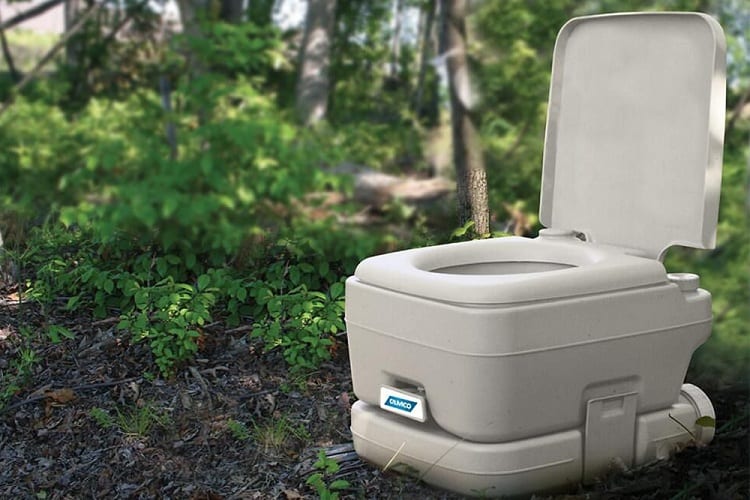
A composting toilet is a type of toilet that doesn’t rely on any plumbing to work, making them a valuable choice for an RV.
Just as the name suggests, these toilets take the waste that’s sent their way and turn it into compost, but the method in which they do this and their efficiency in doing this job differs between each make and model.
These toilets are a common choice in RVs and for camping because they don’t require any water to work, nor do they have to be connected to the vehicle in any way.
Those building eco-friendly homes or hoping to live a sustainable lifestyle might also use a composting toilet, although these models differ slightly from those made for RV use.
The modern types of composting toilets have been designed to keep odors at bay and make sure emptying is done easily and hygienically.
However, not all types are capable of doing this as effectively as others, so you need to choose one that suits your RV’s goals and personal preferences.
How Do They Work?
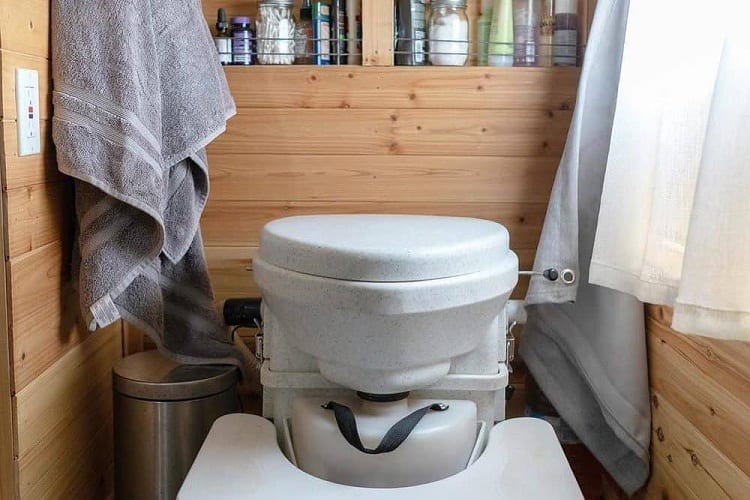
Composting toilets come in different styles that can impact how they operate but generally, they use the same type of setup.
A composting toilet has a lower tank that’s responsible for holding the waste, and once you’re done using it, you press the flush button as usual, and the waste then drops down into this lower area.
Depending on the type of toilet you’re using, there might even be a separate area for liquid waste and solid waste.
With this type of setup, you’re less likely to get odors that you find with traditional toilets in RVs, so it’s a good feature if you can get it.
After the waste has spent some time in the lower tank and it’s been mixed with bulking materials like sawdust, it will start to turn to compost, and this can either be emptied at a waste station or used as compost in the garden, provided it has been treated correctly.
If you’re using one with separate chambers, you may choose to empty the liquid and solid waste at different times depending on what’s needed.
If you’re using one of these toilets regularly, you can wait a couple of weeks in between emptying, provided it’s got enough capacity to handle this much waste and there are no obvious odors.
The Types of Composting Toilets
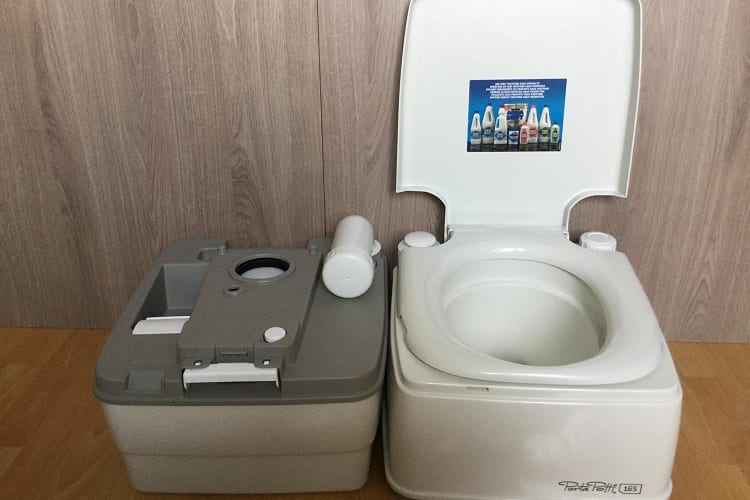
There are a few different types of composting toilets to choose from in your RV, even if the basic premise is the same with all of them.
The first thing you’ll have to decide is whether you want a single or multi-chamber unit, with the better option being multi-chamber.
This means the liquid and solid waste are stored in separate chambers which makes it easier to empty and compost. A single chamber is still effective but may require you to remove the solid waste to allow it to dry, which adds further effort.
Secondly, you’ll have to decide between a self-contained or central compost system.
Self-contained units are all-in-one designs that feature both the toilet and composting tank in a single unit, and these are better suited to the RV lifestyle as they can be emptied easily.
A central system holds the compost in a storage chamber that’s usually built underneath the bathroom so this type of setup doesn’t always work with a portable toilet.
Finally, how the waste is collected and emptied should be considered, as each toilet comes with something different.
The two main choices are a waste liner that can be emptied as needed or a replaceable bucket or chamber that can be swapped out and emptied whenever you want.
If you hope to utilize the compost created from the toilet, the bucket can be left to cure for as long as recommended before it can be used.
Finding a Good Composting Toilet for Your RV
There are three key components to a composting toilet that you’re going to use for an RV. To ensure they work correctly and suit this portable lifestyle, a quality composting toilet should be able to:
Minimize odor
A quality composting toilet won’t smell any more than a regular one and can be left for days without emptying when done right.
The addition of bulking materials like sawdust and peat are used to reduce odors from the waste.
Make compost handling safe
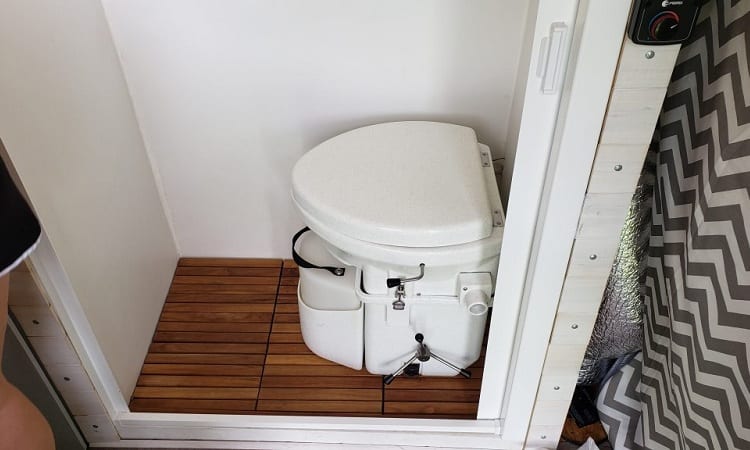
The right system will ensure the final product is safe to empty and there will be features in place that allow you to do so hygienically and comfortably.
In most cases, you’ll add a bulking material to the waste that helps the composting process and makes the waste manageable.
Evaporate moisture
By keeping the liquid and solid waste separately and allowing just a small amount of aeration in, these toilets speed up the composting process. The liquid evaporates eventually and the solid waste turns to compost.
Composting Toilets and the RV Lifestyle
To determine whether a composting toilet is going to suit your RV lifestyle, we’ve weighed up the good and the bad of these setups.
Check out the pros and cons to consider before you go ahead with a composting toilet in your portable home.
Pros
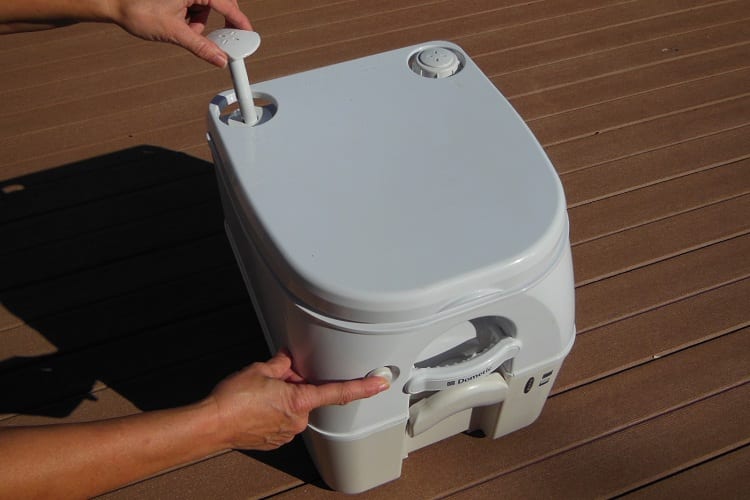
Requires no water
The savings of water that these toilets bring is one of the biggest benefits.
This means you keep more of your freshwater supply for other important needs and will be able to camp without a water connection for longer.
No need for a black tank
Without a regular RV toilet, you have no need for a black tank, so you can take the whole thing out if you wish. In its place, you can add another freshwater tank or a storage tank for used water.
This does require some extra work but it’s a huge bonus that’s worth the effort.
Reduces load
Without needing to keep water in the tank of your toilet, you’ll be surprised at how much weight you lose off your load.
They’re compact as well which means less floor space is taken up, so you won’t feel crowded with one of these in your bathroom.
Easy to setup
Unlike other types of toilets that require connections, hoses, and other parts, your composting toilet is ready to go almost immediately.
The emptying is made easy with separate parts and there’s no need to spend hours setting it all up when you arrive.
Cons

More expensive
If you’re choosing a quality composting toilet, you can expect to pay double what you would a regular RV toilet.
You’re paying for the benefits that they offer and one with functions that make it easy to empty and use, so it’s worth spending extra for this type of setup.
Emptying liquid waste
You’ll need to empty the liquid waste tank regularly otherwise it will overflow into the RV, and this can happen after just a few days of regular use.
To avoid any accidents and spills, it’s a good idea to empty it once a day which adds quite a bit of work.
Some smells
Even though these toilets are marketed as odor-free, it’s not entirely true.
While it doesn’t smell as bad as you’d imagine with the waste just sitting there in a tank down below, it can start to smell similar to manure that’s been used in the garden, which isn’t always pleasant.
Unpleasant to empty
Some people find emptying a composting toilet to be unpleasant, even though you don’t have to touch any of the waste yourself and it’s confined to a bag or liner.
If you’re easily put off by this part of camping, you’ll probably prefer to use a standard waste set up with a black water compartment to store it in.
Environmental Issues to Consider
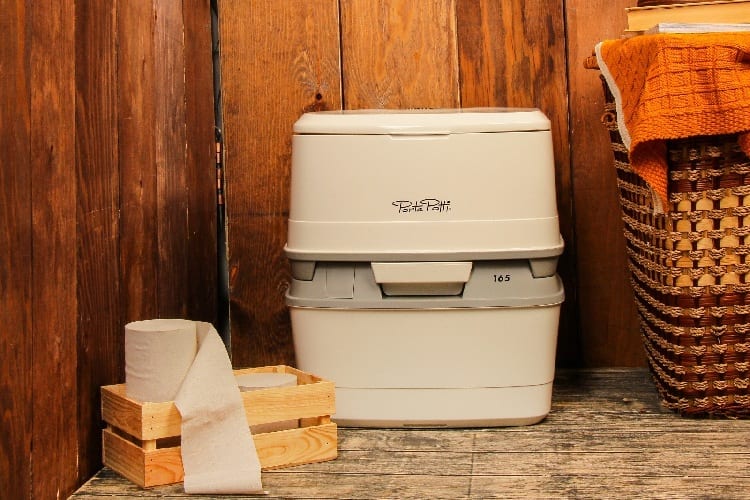
Eco-friendly campers and people wanting to live a more sustainable lifestyle will often opt for the composting toilet because of all of the environmental benefits.
If you’re considering using this type of toilet in your RV because of its reduced impact, you’ll be pleased to know that it has a lot to offer.
Because these toilets don’t rely on any plumbing to work, you’ll reduce your water use and never have to waste your freshwater supply just to use the bathroom.
You can spend longer off the grid because you’ll be saving water, and they only have to be emptied every two to three weeks which is perfect for dry camping and boondocking.
Another boost to the environment comes from the final product that these toilets and your body create.
Once the compost has been treated and cured, it can be used in the garden, with restrictions, so you’ll be able to put the waste back into the earth.
Even if you do choose to dump it at a waste station, it’s a more eco-friendly option than a traditional RV toilet setup.
Is Compost King?
Everyone’s RV setup is different and what you prefer to have in yours will differ from somebody else, and this goes for your toilet as well.
There are lots of benefits to using a composting toilet in your RV but some potential downfalls, so if it sounds like your style of camping, this unique bathroom alternative would be a wise investment.
Related Questions
A composting toilet is an alternative method of bathroom usage in your RV but it might not be favored by all.
If you’re still trying to decide what type of bathroom set up your motorhome needs, read on to see the answers to a few FAQs that can give you a push in the right direction.
How Often Do You Need to Empty RV Toilet?
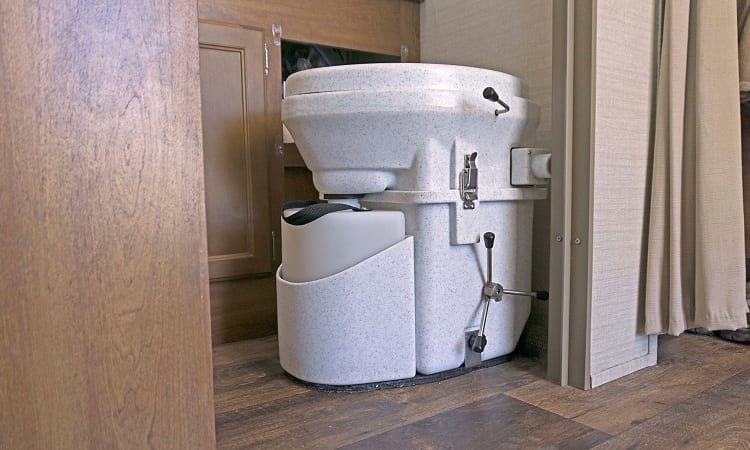
You should empty an RV toilet every two days or so at a designated waste station to prevent build-up, overflowing of waste, and any nasty odors that might be left behind.
The frequency that you need to empty an RV’s toilet depends on its size and how many people are using it during camping so this figure may differ slightly.
Where Do You Empty RV Toilet?
To empty an RV toilet correctly, you should always use a designated waste station.
These portable toilets aren’t connected to a sewerage pipe like they are at home so you’ll have to use a sewer hose and kit to connect the waste cassette or compartment to the outlet at the station so it can be emptied the right way.
Resources:


